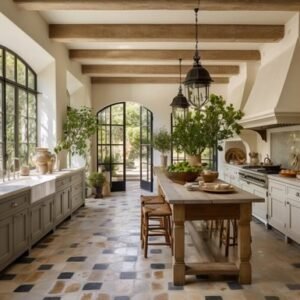The comfortable appeal of country style is timeless and versatile. Warm and evocative, its benchmarks of simplicity, natural materials, and functional design have made it equally suited to traditional or contemporary tastes, and easily adaptable for town or country living.
Rural Nostalgia
Nostalgia for rural life seems to become stronger as our lives are drawn away from the country and into the city. Ever more frenetic, often insecure lifestyles make us long for stability, enduring priorities, and the comforting authority of tradition.
Rustic style, embodied in the rocking chair beside the hearth and its hospitable comforts, symbolizes our continuing need for family values and homestead conventions. It recalls the self-sufficient virtues of thrift and good housekeeping betokened by a pretty quilt pieced from worm-out clothes, logs waiting by the wood-burning stove, and a pantry stocked with produce from the kitchen garden. Rough-hewn stone and plaster, seasoned timber beams, soft pastel limewashes, folk-art decorations, and ready hospitability dispensed from the kitchen table are all part of the look. If the way of life that evolved it has largely vanished, the simplicity of this style makes it perennially and widely adaptable.
The country Kitchen
Traditionally the heart of the home, the kitchen continues to be the informal center of the household, where family members meet and talk across the table at mealtimes. In the past people naturally congregated in the warmest room of the house, heated by the cooking range which was constantly stoked for boiling kettles and keeping ovens hot. In recent decades, architects’ attempts to banish messy food preparation to a small back room have been continually foiled by homemakers who knock down partitions and open up living space so that the cook shares the “sociable kitchen” with family and friends.
Today the refinements of the modern country kitchen have banished the worst elements of the original version – smoke and dust from solid-fuel stoves, small windows, poor ventilation – while keeping the best of its intrinsic style. The twentieth-century kitchen range, the Aga, still performs the same role of general comforter and cook’s best friend.
Tradition continues through painted wooden paneling, glass-fronted cupboards that display dishes, and sturdy worktables used for both preparing and eating food. The fitted kitchen, status symbol of the fifties and sixties, is sometimes giving way again to freestanding country furniture – the hutch (dresser) and the sideboard. In an age which sees cooking as an enjoyable hobby, the country kitchen is as much in demand as ever.
 An important feature of the country kitchen is the dining area, the household’s meeting and eating place. This should be both functional and inviting, incorporating storage for crockery and utensils as well as space for sitting comfortably around the table. Chairs are plain or painted wood, rather than elaborately upholstered, and floors need to be easily cleaned of crumbs and debris: stone flags, ceramic tiles, and varnished or stained boards are popular options. Displays of fruits, vegetables, and flowers are colorful and welcoming.
An important feature of the country kitchen is the dining area, the household’s meeting and eating place. This should be both functional and inviting, incorporating storage for crockery and utensils as well as space for sitting comfortably around the table. Chairs are plain or painted wood, rather than elaborately upholstered, and floors need to be easily cleaned of crumbs and debris: stone flags, ceramic tiles, and varnished or stained boards are popular options. Displays of fruits, vegetables, and flowers are colorful and welcoming.





